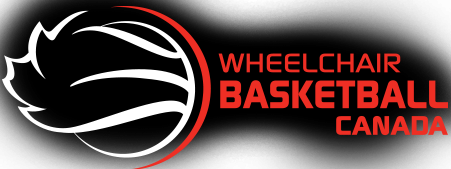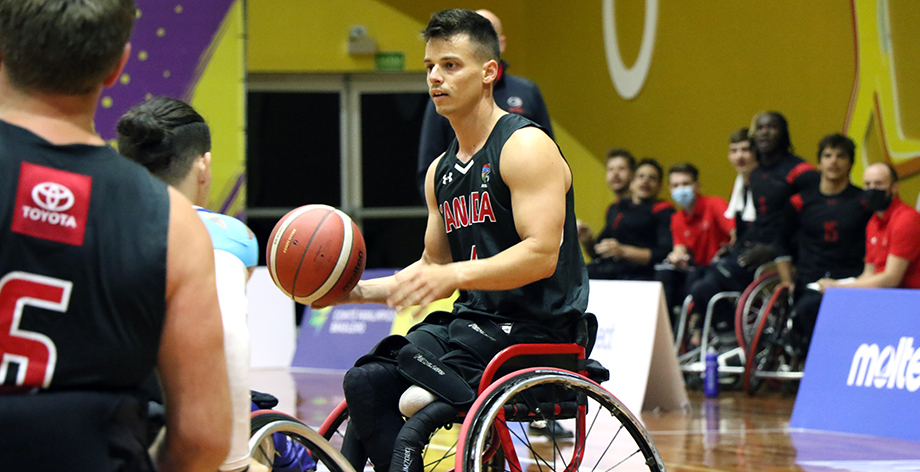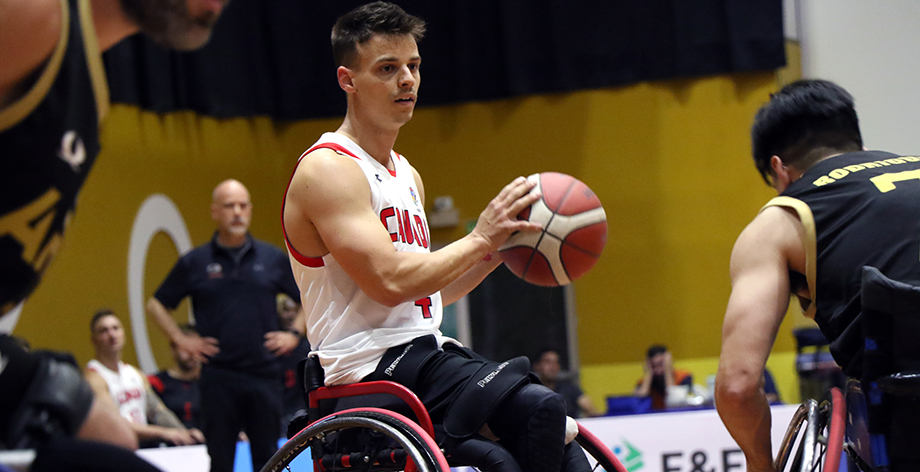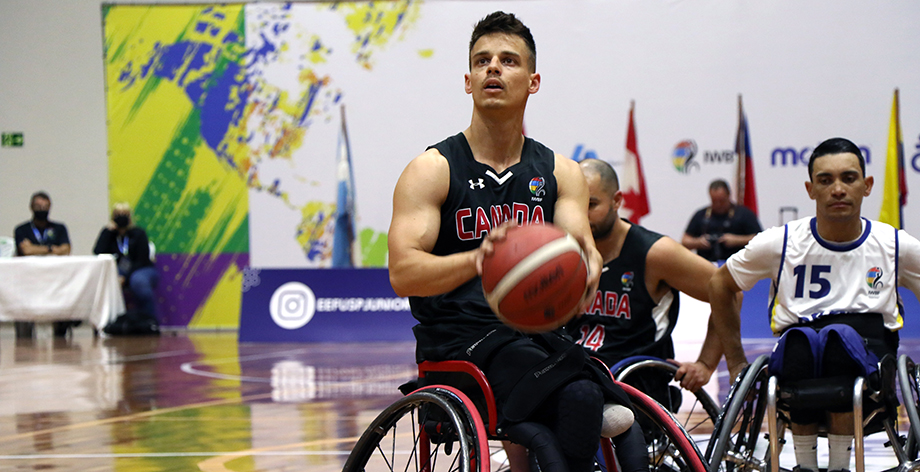Nik chronicles his journey from growing up in Regina and being diagnosed with cancer to finding wheelchair basketball and representing Canada at two Paralympic Games in this month’s Athlete Spotlight presented by Toyota.
Most of my childhood I spent in Regina, in the city, and the latter half of it, we lived on an acreage just outside the city – it really was remote.
Growing up in Regina is the reason I’m into outdoor activities. There wasn’t a ton to do growing up in Regina as far as concerts and such. It’s not a big city. I think there were less than 200,000 people in Regina when I was growing up, so it got me out of the house doing things precisely what you would picture someone from Saskatchewan doing: going through farmers’ fields, ripping on a snowboard, hunting, fishing—that sort of stuff. We don’t have any mountains in Saskatchewan, but we have hundreds of kilometres of flat land, so we’d take our kite, and we’d have our snowboard, and you’d go boarding on the Prairies.
I have twin siblings three years younger than me—one brother and one sister. We weren’t very close growing up. It was enough of an age difference that there was a maturity difference until they hit 20—I was 23, and then our relationship got significantly closer. I like having siblings. It was nice. It’s like we had our own little team.
Introduction to sports
I started skiing when I was six or seven years old—that was the first sport that I got into. We have a little valley about 45 minutes outside Regina – it takes longer to get up the hill than it does to go down, but it was enough to learn on. We’d go out to the mountain for a week every year to go skiing as a family. That was my first introduction to sports.
After I learned to ski, I got into soccer and basketball—then gymnastics took over. I also played competitive tennis for a little bit.
Tennis was trending towards being my sport of choice, so-to-speak. I had a bit of a temper issue on the court sometimes, and tennis is a very mental sport, so it was a challenge at times. I’ve definitely broken a few rackets.
Cancer diagnosis
I got sick during my first year of high school, so I didn’t get to play much high school sports at all.
I was playing basketball and had over-use injuries, and that’s how the pain started in my knee. Over time, the pain I felt in my knee shifted from one location to another. At the time, I didn’t think anything of it.
I was playing basketball one day and went for a jump stop, the defender went past me, and as I landed, I broke my leg. When I broke my leg, I went for an X-ray, and it was immediately evident what was going on—there was a bit of a cloudy formation around the bone. That was how I found out about the cancer diagnosis. That was Grade 9.
Then it was a rush of events. Within two weeks, I was in Edmonton for a biopsy to double-check exactly what it was—bone cancer, which was the initial diagnosis. So I started treatment immediately and had treatments for about 15 months.
At the nine-month mark, I was supposed to have surgery. My fibula was affected by osteosarcoma, the cancer that I had. The idea was they were going to remove that bone in surgery. A couple of days before the surgery, I had a meeting with the surgeon, and a routine check-up, and he explained that the cancer had spread up and down the bone a little bit.
The chemotherapy was working, but it was only working for the soft tissue. In all the surrounding areas the cancer was being killed, but the bone itself, it spread like seven per cent up and four per cent down—it was at the point where there is a nerve that crosses your knee, and it was affecting that nerve.
The doctors essentially said we could still go through with the first plan to remove the bone, but the chances of me getting this cancer again are going to be higher because they wouldn’t be able to remove enough of it. The nerve was affected, so I wouldn’t be able to bend my leg—it’d be a stiff leg, basically useless. They explained that the better option would be amputation.
They gave me the option. To me, it was obvious—I wanted to play sports and still live my life normally. With a stiff leg, it would’ve been more difficult, in my opinion.
From diagnosis to amputation was about two years.
Discovering wheelchair basketball
I was introduced to adaptive sports in high school gym class.
I was going to physio, doing all that stuff, trying to walk again, and no one really mentioned anything about parasport, which is crazy. I think it should be known to everybody. The second you get injured; you should know that you have options. Unfortunately, that was not the case for me.
I was in high school, and they had wheelchair basketball come in for a week—they hired the local club to come in. So they came in, they showed us the chairs and how to move in them. I was still bald at the time; I was wearing sweatpants—the only guy wearing sweatpants in gym class—had a little bit of a swag still.
The coach comes up to me at the end of the week, and he was like ‘Hey, I noticed that you have a little bit of limp’ he didn’t really ask me what was wrong. He was like, ‘You should come out and try wheelchair basketball.’
I immediately dismissed him. I was like, ‘No, I don’t want to play wheelchair basketball. I play able-bodied basketball, it’s very different.’ I was going to try to keep playing able-bodied basketball while wearing my prosthetic. Would I have been as competitive? I knew I wasn’t going to be as competitive.
The wheelchair basketball coach was super pushy. I was trying to dismiss him, but he wouldn’t let it go. He told me to bring a friend, so I brought my brother. I went out on a Thursday, and immediately, I was like, ‘Oh, wow, this is way different than I expected. Way more difficult.’
I got that adrenaline that you get when competing in sports. I could hit people again. I could do all these things again, and I was like, ‘Oh, this is what I was missing.’ The first time you get in the chair, your chair skills aren’t very good—I was terrible. I was pushing as hard as I could. I was around all these people who were buzzing around me, and I was like, ‘This is crazy; this is totally different than what I pictured.’
We had a club in Regina at the Wascana Rehabilitation Centre. The practice was on Tuesdays and Thursdays. So I started going on Tuesdays and Thursdays. Then I got invited to my first Junior National camp after my first CWBL Nationals. One of the coaches with Saskatchewan saw me play at CWBL Nationals and asked me if I would be interested in developing more toward the National Team.
Realizing the potential in wheelchair basketball
In 2009, I had my first international competition in France. Getting the opportunity to represent Canada like that was crazy. It was in Paris, and it was my first multi-sport event. First international tournament of any sort—my flight was paid for, and I was rooming in downtown Paris with all these athletes. It was such an incredible experience. It was one of the very first times I travelled on my own.
Then I found out the full potential of the game. I realized I could go to university—some universities offer wheelchair basketball. I was about a year out from university at that point. That’s when I realized, ‘Maybe I could do something with this,’ and I went to the University of Illinois.
Mike Frogley was the one who opened my eyes to the potential with wheelchair basketball. His message was, ‘You can take this as far as you want, depending on how hard you want to work at it.’ He outlined the options, and then the rest was kind of up to me. He definitely played a big role in mentoring me that first 4-5 years.
I attended the University of Illinois and majored in kinesiology with a biomechanics specialty. Frog, the Canadian coach at the time, coached at Illinois. He coached me in university for two-and-a-half years.
The number of things I learned, just about life and living on my own, having a new disability and then, on top of that, all of the basketball stuff—it was huge for my growth.
I wasn’t one of those people who, at a young age, thought I would be a professional athlete. I come from an immigrant family, and it was very much school first, ‘Are you going to be a doctor or a dentist?’ Those were the options.
When my parents realized I could go to university on scholarship and play wheelchair basketball—that was when the sell happened. Up until then, my parents were just like, ‘Oh, he’s having fun doing his thing, it’s not that big of a deal.’
Then it was like, ‘Oh, Nik got a full-ride scholarship to a pretty respectable school’—then they were starting to buy in a little bit more.
I took a gap year after the 2016 Paralympics, and moved to Germany. I played professionally in Germany for a year—I wanted to scratch that off my bucket list.
Finding a career path
When I returned to Canada, I got accepted into the master’s program at UOIT in Oshawa in exercise physiology. Then, I went to George Brown University, where I specialized in orthotics.
I got into the orthotics field because, as you get older, you look back at your life, at how things have played out and at the people who have impacted your life. I was at that transition point where I needed to decide on a career.
With exercise physiology, there are not many jobs, as much as I like the field. I didn’t want to do research—I am not a huge fan of writing publications and things like that—it’s quite a gruelling process.
I thought to myself, ‘What could I do that would be fulfilling, that I could help people?’ That was always something I wanted to do—whether it was helping athletes to perform or, in my case, now where I am helping kids walk properly or with fewer problems. The field of orthotics seemed obvious.
I kind of realized how big of an impact my prosthetist had on me. If you lose your leg, your life completely changes. My prosthetist had lost his leg 25 years prior due to osteosarcoma, the same thing as me. Similar conditions as me. He had a wife, he was driving a motorcycle, he was part of a band, and he was doing all these things. So, I was like, ‘Oh, okay, if he can do it, I can do it.’
First Paralympic Experience
It was very challenging. We had a massive shift in the team after 2012. We won gold in 2012, and then half the team retired.
As a result, we had a new squad. We didn’t qualify for World Championships, which was two years before the 2016 Games. It was hard. Being a new guy on the team with all the athletes that had retired, I was kind of thrown into a role where to be one of the guys, so it was challenging. I don’t have super positive memories from the Rio Games, but I obviously learned a ton from it.
Then for, the 2020 Paralympics, it was an entirely different experience. After Brazil, I knew how I didn’t want to feel and how I didn’t want anyone else to feel. Everyone bought into that idea, and it was an entirely different experience.
Advice for new athletes
Don’t be shy to just try. Try everything and anything. It doesn’t have to be wheelchair basketball—try sledge hockey, try Nordic skiing, try sit skiing—try whatever options that you have. Try it all. Don’t make a prejudgment because it is not what you pictured 99 per cent of the time.





